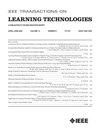以竞赛为导向的学生团队建设方法
IF 2.9
3区 教育学
Q2 COMPUTER SCIENCE, INTERDISCIPLINARY APPLICATIONS
引用次数: 0
摘要
许多重要而有趣的学科竞赛吸引着越来越多的学生参加。然而,传统的学生团队建设方法通常具有很强的随机性,或者只涉及一些一流的学生。为了选择更合适的学生组成团队,全面提高学生的能力,我们提出了一种以竞赛为导向的学生团队建设方法。这不仅能通过选择更合适的学生和团队来获得更好的竞赛结果,还能提高学生的整体参与度,考虑教育公平。首先,构建大数据平台,收集学生的各种行为数据。在此基础上,对具有六元属性的竞赛和具有六元属性的学生进行建模。然后,为学生模型中的每个属性设计相应的效用函数,以表示学生参加比赛在该属性上的效用。此外,还为每个团队设计了一个团队效用函数,以表示所有参赛学生的效用。还开发了一个团队建设效用函数,以表示所有参与团队的效用。其次,提出了一种逐维改进的多目标粒子群优化算法来建立合适的团队,以同时优化团队建设效用最大化和教育公平性。最后,大量的实验结果表明,我们提出的建队方法的整体性能不仅在团队效用和学生能力方面优于其他现有方法,而且在超体积和倒代距离方面也优于其他优化算法。本文章由计算机程序翻译,如有差异,请以英文原文为准。
A Competition-Oriented Student Team Building Method
There are many important and interesting academic competitions that attract an increasing number of students. However, traditional student team building methods usually have strong randomness or involve only some first-class students. To choose more suitable students to compose a team and improve students' abilities overall, a competition-oriented student team building method is proposed. This would not only lead to better competition results by choosing more suitable students and teams but also improve the overall involvement of students in considering education fairness. First, a Big Data platform is constructed to collect students' various behavior data. Based on that, a competition with a six-tuple attribute and a student with a six-tuple attribute are modeled. Then, a corresponding utility function is designed for each attribute in the student model to denote the student's utility in this attribute for attending a competition. Furthermore, a team utility function is developed for each team to denote the utilities of all involved students. A team building utility function is also developed to denote the utilities of all involved teams. Second, a multiple-objective particle swarm optimization algorithm with dimension by dimension improvement is proposed to build appropriate teams to optimize team building utility maximization and education fairness simultaneously. Finally, extensive experimental results demonstrate that the overall performance of our proposed team building method not only has better performance in terms of team utility and student ability than other current methods, but also has better performance in terms of hyper volume and inverted generational distance than other optimization algorithms.
求助全文
通过发布文献求助,成功后即可免费获取论文全文。
去求助
来源期刊

IEEE Transactions on Learning Technologies
COMPUTER SCIENCE, INTERDISCIPLINARY APPLICATIONS-
CiteScore
7.50
自引率
5.40%
发文量
82
审稿时长
>12 weeks
期刊介绍:
The IEEE Transactions on Learning Technologies covers all advances in learning technologies and their applications, including but not limited to the following topics: innovative online learning systems; intelligent tutors; educational games; simulation systems for education and training; collaborative learning tools; learning with mobile devices; wearable devices and interfaces for learning; personalized and adaptive learning systems; tools for formative and summative assessment; tools for learning analytics and educational data mining; ontologies for learning systems; standards and web services that support learning; authoring tools for learning materials; computer support for peer tutoring; learning via computer-mediated inquiry, field, and lab work; social learning techniques; social networks and infrastructures for learning and knowledge sharing; and creation and management of learning objects.
 求助内容:
求助内容: 应助结果提醒方式:
应助结果提醒方式:


